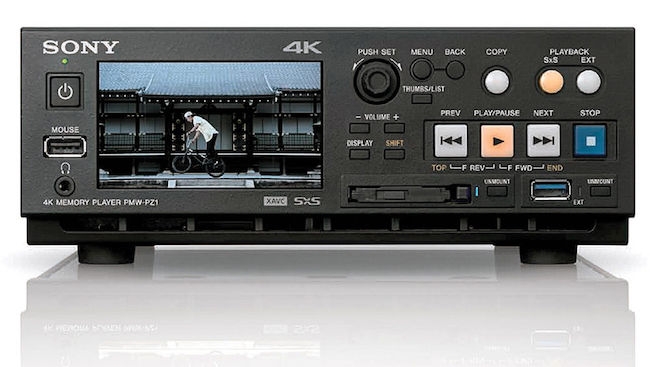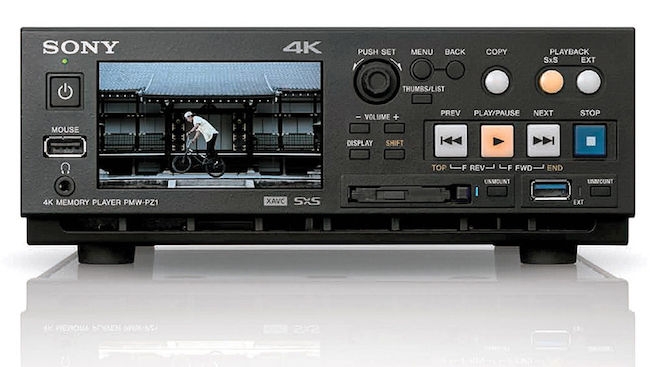
 Sony's new PZ1 - does one thing and does it well
Sony's new PZ1 - does one thing and does it well
The Sony PMW-PZ1 is an intriguing compact deck for the company's XAVC memory camcorder ecosystem. Correctly marketed as “4K playback for everyone,” the deck is a convenient and flexible alternative to an expensive high-powered laptop to review and backup your digital footage.
The sub $3000 product looks to fit into three markets: On location as a tool for reviewing and copying footage to external drives, the post production room for creating USB delivery and archival digital prints, and in exhibition as a playback device for HD/4K projectors and digital signage (this includes trade shows, large format display venues, and retail).
To my great joy, the device is wildly simple. With absolutely no guidance or introduction I was able to intuitively navigate all of the deck's functions in under five minutes.
The PZ1 has a familiar face, one very similar to that of a standard VCR, with large, clearly labeled tactile buttons. Now, this might read as a bizarre thing to focus on, but in our modern touch-screen world I feel as though the fine art of hard interface design has fallen aside. It's part of what made figuring out the PZ1 so easy.
There are two connections for media, an SxS slot on the front and a USB 3.0 connection on the back for attaching external drives for both reviewing footage and making copies of dailies.
Also on the face, a 3.5” display with a 960 x 540 16:9 display which was surprisingly bright and sharp for its size. While not large enough for fine quality control, the monitor is perfect for spot checking and basic reviewing purposes. I could easily see a story producer sitting with the PZ1 taking notes and making selects.
The PZ1 is roughly eight by seven inches wide, and no taller than a deck of playing cards. Weighing in at around 5lbs, this is a device that's designed to be portable.
Sturdy build quality
Anyone who has dealt with the DVCAM, HDCAM, and Beta playback decks of yesteryear will remember the hefty size and weight (especially if you ever had the misfortune of having to rearrange a machine room!). Even the most compact DVCAM decks had a decent heft to them; so the slimmed back design is certainly welcomed.
The build quality, as can be expected in any professional Sony product, is superb. The buttons are solid and responsive including the “push / set” click wheel which always tends to be weakest part of any product that decides to integrate them. For a device its size the connections and ports are incredibly sturdy.
While I'm not likely to dropkick and play a game of catch with it, I feel confident that if the PZ1 took a tumble off the DI table it would survive to see another day.
As a location and post production person, my thoughts immediately rocket to how the PZ1 is basically a DI cart in a box. One of my personal pet peeves about shooting on digital stock on location is the lugging of extra laptops, screens, and the like. If you're producing programmes within the Sony ecosystem of XAVC memory based camcorders, say shooting a documentary or TV commercial with the FS7, you can reduce your 4K DI-Cart to a the PZ1 and a pile of drives.
Likewise, if you're looking to do work with high-resolution displays, you no longer have to carry around a massively expensive laptop, adaptors, various cables etc., you only need this box, standard cables and your display.
Wish list
From an on-location and production standpoint, there are a few things that I would love to see added in future versions of this product:
Additional format support – This is really a production centric critique. While the PZ1 is great if you're working within the XAVC ecosystem, it's rare to find one's self working with only one brand of camera these days. t'd be great if I could, possibly with an adaptor, drop in my GoPro, C300, or BlackMagic ProRes / MXF files for review and copying as well.
Workprint / Proxy generator – Okay, I admit this is a stretch, but how cool would it be if a deck like this could not only make a backup of your full resolution media, but make a second proxy copy that could easily match back to the originals?
In many ways this device reminds me of a 21st century iteration of the DSR-11, Sony’s compact DVCAM deck that was wildly popular during the digital video revolution of the early 2000s. The DSR-11 was popular because it was an essential tool that provided hit the perfect intersection of price and performance while allowing you not the put wear and tear on your camera's videotape heads.
But the PZ1's similarity to the DSR-11? This brings up an interesting question: is there space in the contemporary market for a device that is designed for a defined number of functions? My answer to this is, in the case of the PZ1 is: Yes, albeit a more limited one than say the DSR-11 had back in the early 2000s.
The Great All-Machines
We live in the times of what I like to call “the Great All-Machines,” where our phones and laptop seem to be the central point of “everything related to all the things.” Our All-Machines seem like they can do anything and everything. You can use the same machine to mail-order a new pair of shoes, do your taxes, and edit a feature film at the breakfast table.
Yet, while laptops, phones, and tablets are great multi-tasking devices, they can also be the source of incredible stress and time-consuming workarounds. Be it a huge bag of adaptor cables, OS/drive incompatibilities, proprietary media or player issues (the list goes on), there is always some point of complexity that complicates a process that used to be as easy as “put the tape in the player, hit play.”
The PZ1 streamlines a very important part of the media handling process. The best part is the fact it works with the touch of a few buttons. Straightforward. Uncomplicated. Reliable.
This is the sort of technology that speaks to me.
Tags: Production


Comments